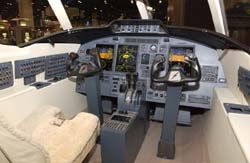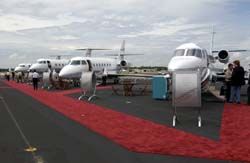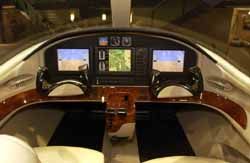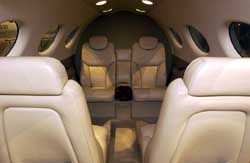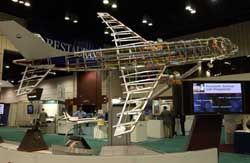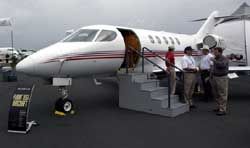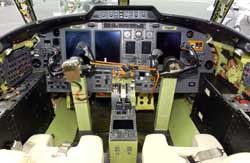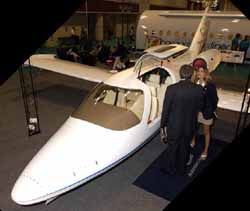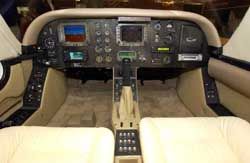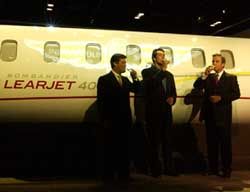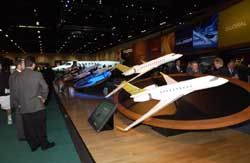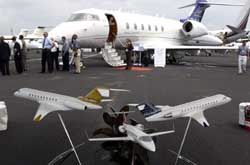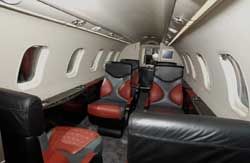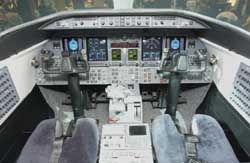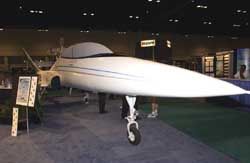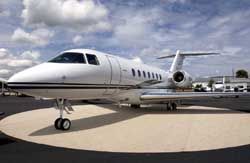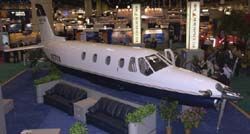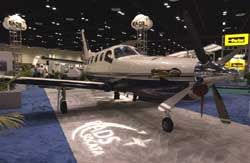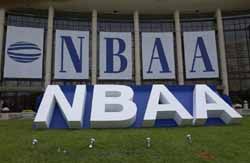 | |
The Smothers Brothers hadn’t yet taken the stage for the annual safety awards banquet that closed out official business for the 55th Annual Meeting and Convention of the National Business Aviation Association when the airways leading out of the Orlando Class B started to fill with departing aircraft. But surprisingly, many an NBAA static-display airplane waited for Friday the 13th to take the long way home. Sated but not overly filled, the 27,785 who attended this year’s return-to-normal event seemed so much more like the fine, enthusiastic crowd we’ve come accustomed to seeing and so much less than the somewhat shell-shocked throng of fewer than 12,000 who ventured to New Orleans last year for the rescheduled 2001 event.
Perhaps we are all getting a bit closer to the “normal” state we were urged to resume shortly after last year’s terrorist attacks put the general aviation world into a seemingly permanent aerobatic state: turned, tossed, and upended without even a hint of a threat to even the smallest public gatherings. Nevertheless, NBAA President Jack Olcott spent some unplanned time dealing with security briefings Tuesday afternoon after hearing from the Transportation Security Administration that the government was elevating the level of security alert going into Sept. 11, 2002 — one of six aviation-association execs so briefed in the first wave.
But all in all, Olcott smiles a good bit more than last year. The numbers looked more like the “old days,” and enthusiasm outweighed solemnity compared to 2001’s convention.
(click photos for larger versions) | |
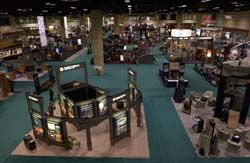 | |
Last year, NBAA suffered by being the first association to feel the brunt of the 9/11 attacks because of its previously scheduled Sept. 18, 2001 opening date. The NBAA board wisely moved to delay the convention, costing significant losses for most of the near-record number of exhibiting companies, large and small.
But the delayed event necessarily fell between the Thanksgiving and Christmas holidays, and last year’s 54th NBAA suffered more for it — even after AOPA Expo attracted a near-record, normal crowd only three weeks earlier. Most of the majors that followed — HAI, Sun ‘n Fun, AEA, Oshkosh, etc. — drew audiences and exhibitors in numbers close to or better than normal.
This year’s NBAA included acknowledgements of the victims of terror, on opening day (Tuesday, Sept. 10), and again Wednesday, on the first anniversary of the attacks. The association’s American Spirit Award went to the passengers and crew of United Flight 93, whose efforts helped put the plane into a Pennsylvania field instead of its believed target in Washington, D.C.
So, in a sense, NBAA’s opening day this year closed the circle started a year ago, and what a relief to see that NBAA number 55 held the same place in the annual calendar as usual: the world’s largest, purely civil, aviation trade show.
It’s Not Just Numbers — But NBAA 2002’s Numbers Don’t Hurt
Audience, exhibitors, and static displays all hit their marks at Orlando
There are yardsticks and yardsticks, but among the leading indicators of any major event (and for any major community) is the health and vitality of its suppliers. Participants and unit-sales numbers all help, equally.
And the 55th annual NBAA more than held its own — even overlapping the first anniversary of you-know-what.
One thousand eleven vendors filled more than 900,000 square feet of exhibit space in the Orange County Convention Center (OCC), a hall with more than a million available. This place may not have been filled to the gills, but it looked chock-a-block. And for what it’s worth, the space used was about 50 percent greater than the last NBAA visit to the OCC in 1996 — and about the same percentage higher than last year’s delayed event in New Orleans.
Manufacturers and resellers put 151 business aircraft on the static display at Orlando Executive Airport with the help of hosts Showalter Aviation, one of two top-notch FBOs handling the overflow of aircraft that filled ORL’s ramps and taxiways. Six business aircraft made their first-ever NBAA appearances, a record. Better still, many of the exhibiting companies treated NBAA like the world-class trade event it has long been, erecting the most numerous and palatial hosting facilities we can remember for this convention.
And then there were the NBAA members themselves. They didn’t come out in record numbers, but they came out in wholly normal numbers, at nearly 28,000 — numbers far higher than NBAA’s last meet in Orlando.
Some are still handicapped by on-again-off-again operating constraints, some struggle to overcome nearly xenophobic restrictions on foreign flight students and foreign pilots flying in the good ol’ USA, and some are hampered by restrictions on operations by foreign-registered aircraft.
The mood of excitement, many observed, was a result of the opportunity to return to a “normal” NBAA convention, and anticipation of a world likewise resuming a more familiar pattern of life.
Normal, Redefined: “Flight Security” a Term Still New to the Ear
Security Council is NBAA’s newest operators committee
Some Americans took note of another anniversary amid the tears and pronouncements that filled Wednesday, Sept. 11, 2002. Since that same date in 2001, U.S. citizens have been denied access to the nation’s capital airport unless they buy a ticket on a commercial carrier. At three other fields nearby to Ronald Reagan Washington National Airport (DCA), only based-aircraft can operate, and then only with special procedures.
And whenever authorities deem something credible, they can yank the airspace access of hundreds of thousands of citizens with little notice and less explanation, as happened Tuesday evening when the state of homeland security alert went up one pastel level.
That sudden change in state for private aviation is, as one NBAA member put it, part of “what’s normal, today.” A retired military combat pilot, the corporate flight-department executive expressed some reservations about how new rules allow the government to unilaterally close part of America to any American citizen who chooses to travel by private plane. “We can’t use National; we often need special access to other airports depending on its proximity to an event — We don’t deserve this treatment.”
So, one of the new items undertaken by NBAA members at this convention was the formation of the NBAA Security Council. Chaired by the immediate past chairman of NBAA’s Safety Committee, AT&T’s Douglas Schwartz, the NBAA Security Council came into existence to improve the access of the association’s efforts in several areas which security issues now manifest themselves separately from operational agencies and issues.
By creating the Security Council, the association also hopes to increase its participation in the government security dialogue, help operators win government approval for their security practices, and revoke the discriminatory closure of DCA to general-aviation operators — primarily business-aircraft users.
“Today’s security issues determine access to airports and airspace,” said NBAA’s Olcott. “NBAA is focused on maintaining the excellent record of secure operations by corporate flight departments.”
Safety of flight and the security of life provide two of the foundation elements behind the creation of the NBAA back nearly six decades ago. Listening to briefings and forum discussions over the years makes for an instinct to pay attention even more closely when hearing phrases such as “safety-of-flight issues.” Every activity has its norms.
The norm for general aviation today now includes the words “flight security,” and it’s taking on the makings of an institutional player on par with, but separate from, flight safety. Given the efficiency and effectiveness shown thus far by the creation of a security bureaucracy, separate from aviation but with vast, restrictive powers over even the FAA, we’re certain that the creation of industry-based mechanisms for addressing operational issues makes more sense within an NBAA than inside a DOT.
Business-As-Usual — Or Even Better; Commerce Can’t Stand Still
Like last year, the vendors were smiling
Flight Deck and Cabin New planes, sales gains, fading economic pain, the sight of the light at the end of the tunnel — and knowing it’s not an oncoming landing light while you use Runway 18 on a Runway 36 day. Yes, this was a strong show for the businesses that filled those 1,011 displays.
New-plane sales? Well, to be honest, they were part grandstanding, part real commerce, and all interesting.
On Thursday, we told you about the advanced sales of new planes by Cessna and Gulfstream to NetJets; we noted Cessna’s advanced sales for the CJ3 and Citation Mustang — the latter of which required only a $10,000 commitment. All in all, the week proved some of what Honeywell and other forecasters have predicted: Planes are still needed, and sales are still happening for deliveries that will be some time downstream.
“We’re having an excellent time here,” said one Cessna insider. “The Mustang is attracting attention like nothing we’ve seen before.” The test, the insider noted, comes when those $10,000 intent-to-buy payments face conversion to $75,000 deposit-contracts. “Given the numbers we’re getting from the customers we’re seeing, it isn’t a problem we’re too worried about,” the insider concluded.
Overall, sales at the 55th NBAA appear even better than the $2 billion-plus recorded the past two conventions in New Orleans. Of course, some of those sales won’t conclude as intended, just as some of this year’s orders will fail for one reason or another.
Case in point: At NBAA 2000, a new super-mid-size jet announced by one major planemaker attracted huge interest, thanks to a combination of performance, price tag, and timing. The project was ultimately shelved, and the sales largely moot, at least, for now.
So it’s with a clean conscience that we report some of what we know of advanced sales logged at NBAA 2002; some of these sales won’t close — for a variety of reasons.
From Bombardier late in the show, a Global 5000 and a pre-owned Lear 31A — and that’s in addition to other deals behind the scenes. The Cessna rundown: Citation Mustang, nearly 200 deposits as of Thursday afternoon at show’s close; the new CJ3, comfortably above 150 orders. From Raytheon Aircraft’s newly announced Hawker Division, the sale of three 800XPs and a Horizon; from the Beech side, three King Airs, a Bonanza, and a Premier I.
And these are additional to deals we mentioned Thursday, such as the $2 billion order from NetJets that included 50 G150s from Gulfstream and 100 of those CJ3s mentioned above.
New Faces: Debut Showings of Old and New Jets
Progress is the real deal that makes buyers and investors smile
(See Mockup Flight Deck below) Something new showed up for the NBAA 2002 static display at ORL — well, something old, something new — and it wasn’t a wedding deal. No, it was the first production Sino-Swearingen SJ30-2 business jet. Taking a break from its flight-test work, this workhorse light-jet gave thousands their first up-close look at a jet in the works since the mid-1990s. (No, it’s really not the same jet Ed Swearingen introduced in the late 1980s.)
The SJ30-2 may have been the longest-awaited first appearance at an NBAA to occur this year; it was not the only first appearance, however. Bombardier Learjet’s weeks-old Learjet 40 also took time off to shine for its makers. And we’re talking about the first production version, painted, finished, and looking ready to work for its dinner.
Bombardier’s former Continental arrived from the company’s Flight Test Center in Wichita with a new paint job, some updated expectations, and a new name to match: the Challenger 300. As part of Bombardier’s re-branding — the company now has the Learjet, Challenger, and Global lines — the Challenger 300 is part of the fastest-growing segment in business aviation, the mid-size jet.
Hawker’s striking Horizon attracted plenty of attention at the static display, as did the existing four of Gulfstream’s new seven-jet lineup. New Piper and EADS/Socota both announced upgrades and updates to their single-engine propjet models: respectively, the Meridian and the TBM700C2.
Adam Aircraft showed off the A500, as did two other names familiar to folks at the lighter end of the market: Javelin and Maverick.
Of course, Eclipse was perpetually awash in people, thanks to the sequenced rollout and first flights that preceded the NBAA convention by only a few weeks. With more than 1,300 firm orders, more than 700 options, and a price guaranteed to be within 5 percent in year-2000 dollars, the little Eclipse 500 draws interest growth in direct proportion to its proximity to certification. Meanwhile, the margins for the naysayers narrow by equal proportions.
Flight Deck And at the other end of the scale, Gulfstream’s sales of the huge GV and GV-SP are above the 200 mark, Bombardier’s Global hovers under 100, Boeing Business Jet’s 737-based BBJs boast of more than 70, and Airbus’ A319ACJ is approaching the mid-teens.
Trying to gauge who sold most depends, as you might be able to see, as much on definitions as anything. If dollars are the reigning yardstick, the big guys are serious contenders for best-in-show marks; if unit sales are the arbiter, well, although the contenders may be closer overall, there’s still only one likely winner, and this company has long led the annual jet-delivery numbers (see above).
Delving deeper into engines and avionics and forecasts and outlooks takes more space and time than this feature can deliver. But you probably understand that across the room, where business is great for some, it’s not always great for others.
Training institutions are hurting, as are some overhaul and repair outlets.
Requirements for new Domestic Reduced Vertical Separation Minimums flight is spurring some new waves of entrepreneurship and development; likewise for new security requirements in regards to the defense and in-flight security needs, with what seems to be an entirely new business segment emerging.
Synthetic vision and FLIR-based cockpit-enhancements are further extending the range of foul weather we can safely navigate. And the promises of ADS-B and further in-cockpit weather gear continues to grow.
We need only to continue to enjoy freedom of movement for much of this stuff to be worth the investment.
NBAA 2002: A Convention That Exceeded Its Perceived Potential
Not the best, not the worst, but better than would be expected
The sourest words heard at NBAA 2002 addressed airspace and security authorities, the vagaries of clearing airline security checkpoints at airports so served, and some of the inanities of the watchers over our homeland security efforts.
But with the positive tone offered and shown by the TSA at the convention, the relative normalcy of attendance, and the lack of anything more disruptive than a lost STMP reservation, the 55th NBAA convention came, did, and went with strength, pride, and enthusiasm. Continued optimism on the part of operators, suppliers, and manufacturers seemed to reflect much of America’s spirit a year after that life-changing morning of Sept, 11.
And with the crowds back, record vendor attendance, and the indications of record levels of business, the NBAA convention seemed again to reflect the spirit and pride of America overall.
More than ever, the need for personal air-travel seems affirmed by the times — and not merely for captains of industry and shapers of capitalism. We saw more families traveling by small plane this trip, families for whom past holiday trips involved lengthy encounters with checking car seats, hanging on diaper bags, and making the best of the vagaries of common carriage.
For anyone with the motive, means, and wherewithal, the experience of NBAA 2002 should be further reinforcement that nothing is more convenient nor more easily accomplished than a lengthy trip in a private plane. America needs general aviation, just as general aviation needs Americans’ support.
NBAA may be the place where the merger of those two needs manifests most visibly.
Here’s to an even better example, when the NBAA convenes for its 56th convention, Oct. 7-9, 2003, back here in the OCC.
About the Author/Photographer…
Dave Higdon has a distinguished background in aviation journalism. As aviation editor for The Wichita Eagle for more than five years, he has established a reputation as one of the best general aviation reporters in the business. Previously, Dave held a variety of aviation journalism assignments with The Journal of Commerce, Air Transport World, and AOPA. He has covered every facet of aviation, from sport aviation in Tennessee, to the FAA in Washington, D.C., to Cessna, Beech, Boeing, and Learjet in Kansas. He’s also a professional aviation photographer. Dave is an instrument-rated private pilot and owns a very clean Piper Comanche. He and his wife Annie live in Wichita, Kansas.


































